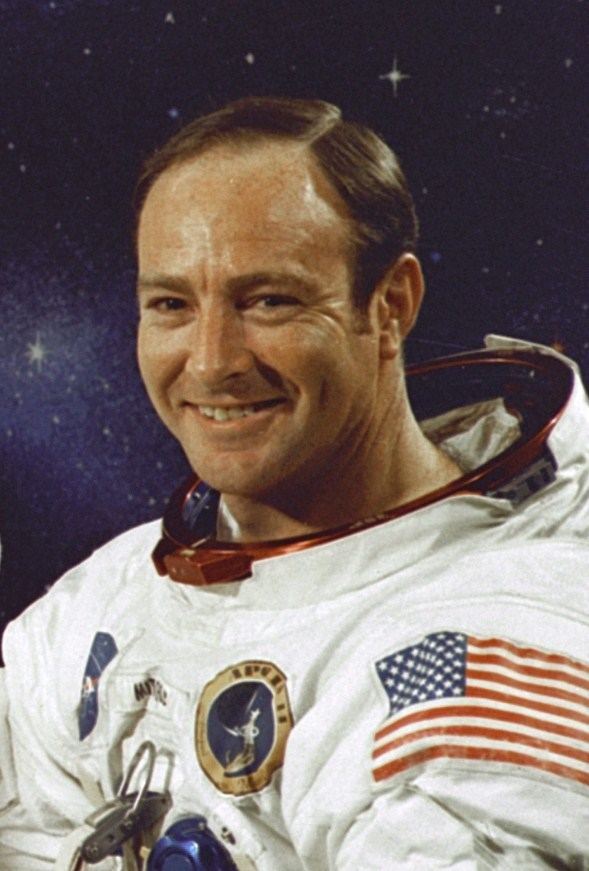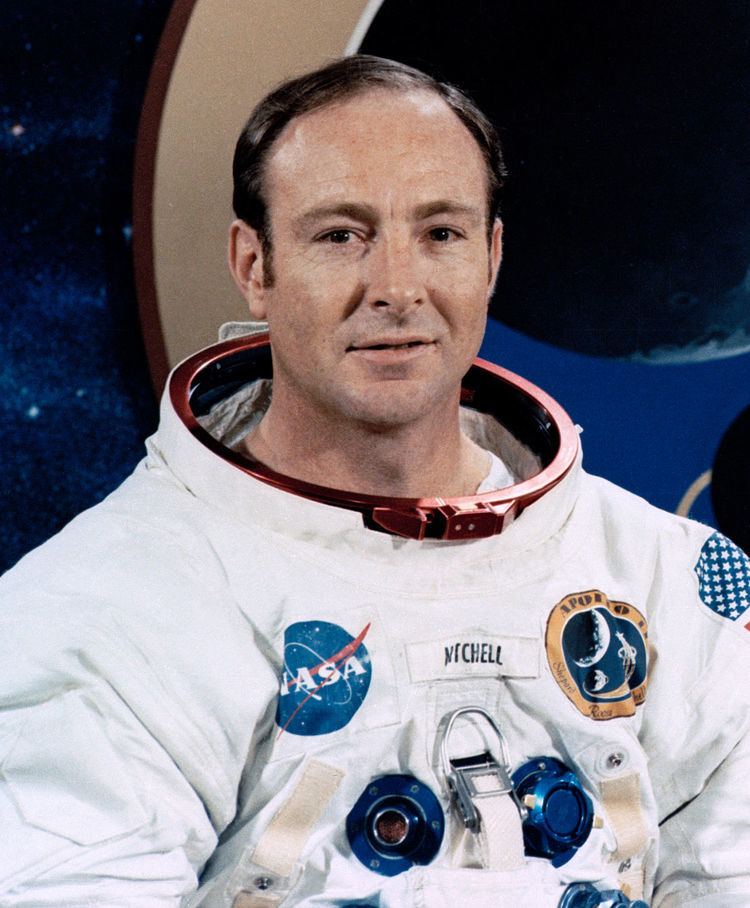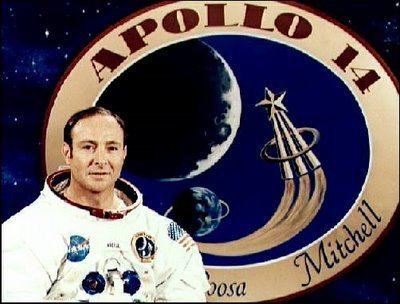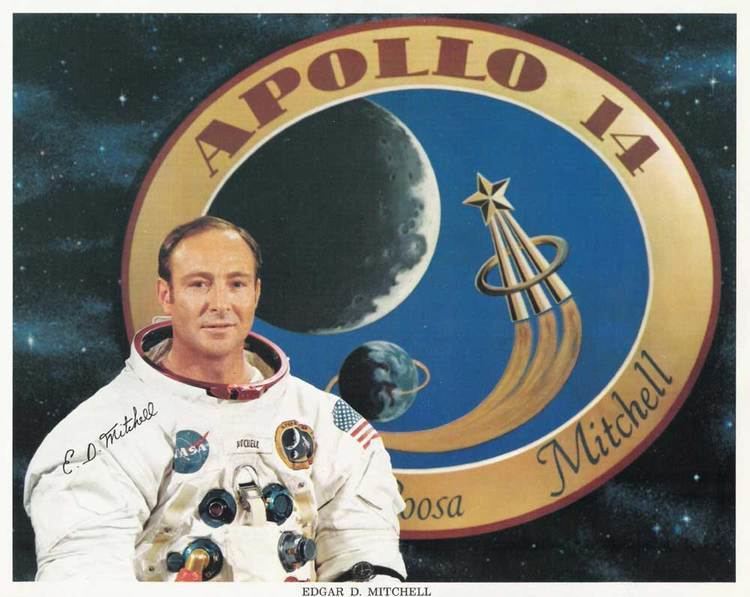Nationality American Time in space 9d 00h 01m Status Retired Name Edgar Mitchell | Other occupation Test pilot Role Aviator | |
 | ||
Alma mater CIT, B.S. 1952NPS, B.S. 1961MIT, Sc.D. 1964 Books Psychic Exploration: A Challenge for Science: Understanding the Nature and Power of Consciousness Spouse Sheila Sisco (m. 1989–1998), Anita Orr Rettig (m. 1972–1984) Children Adam Blake Mitchell, Kimberly Ann Mitchell Similar People Alan Shepard, Stuart Roosa, Gordon Cooper, Charles Duke, Pete Conrad | ||
Apollo 14 astronaut hits a golf ball off moon in 1971 - Daily Mail
Edgar Mitchell
Edgar Dean "Ed" Mitchell (September 17, 1930 – February 4, 2016) was a United States Navy officer and aviator, test pilot, aeronautical engineer, ufologist and NASA astronaut. As the Lunar Module Pilot of Apollo 14, he spent nine hours working on the lunar surface in the Fra Mauro Highlands region, making him the sixth person to walk on the Moon.
Contents
- Apollo 14 astronaut hits a golf ball off moon in 1971 Daily Mail
- Edgar Mitchell
- Early life and education
- Flight experience
- NASA career
- Post NASA career
- Remote healing
- Views on UFOs
- Other projects
- Death
- Organizations
- Awards and honors
- In media
- Books
- References

Early life and education

Mitchell was born on September 17, 1930, in Hereford, Texas. He came from a ranching family that moved to New Mexico during the Depression and considered Artesia, New Mexico (near Roswell) as his hometown. He first learned to fly at 13 and was active in the Boy Scouts of America where he achieved its second highest rank, Life Scout. He was also a member of DeMolay International, part of the Masonic Fraternity, and was inducted into its Hall of Fame. Mitchell was a member of Artesia Lodge #29 in New Mexico. He enjoyed handball, tennis, and swimming, and his hobbies included scuba diving and soaring.

He graduated from Artesia High School in 1948. Mitchell received a Bachelor of Science degree in industrial management from Carnegie Mellon University in 1952. The following year he joined the U.S. Navy, and completed basic training at San Diego Recruit Depot. While on active duty in the Navy, he earned a second bachelor's degree in aeronautics from the U.S. Naval Postgraduate School in 1961 and a Sc.D. in aeronautics and astronautics from the Massachusetts Institute of Technology in 1964.
He was twice divorced, and had three children, three stepchildren, and nine grandchildren.
Flight experience

In May 1953, after completing instruction at the Officer Candidate School at Newport, Rhode Island, he was commissioned an Ensign. He completed flight training in July 1954 at Hutchinson, Kansas, was designated as a Naval Aviator and was subsequently assigned to Patrol Squadron 29 (VP-29) flying land-based patrol planes, deployed to Okinawa.
From 1957 to 1958, he transitioned to carrier-based jet aircraft and flew the A3D Skywarrior while assigned to Heavy Attack Squadron Two (VAH-2) deployed aboard the aircraft carriers USS Bon Homme Richard and USS Ticonderoga. He qualified as a research pilot and flew with Air Development Squadron Five until 1959. Following the completion of his graduate studies, he served as Chief, Project Management Division of the Navy Field Office for the Manned Orbiting Laboratory from 1964 to 1965. From 1965 to 1966, he attended the U.S. Air Force Aerospace Research Pilot School for certification as a test pilot, graduating first in his class. During this period, Mitchell served as an instructor in advanced mathematics and navigation theory for astronaut candidates.
Mitchell was a member of the Kappa Sigma fraternity, and carried one of the order's badges to the Moon; it is now kept at his home chapter of Kappa Sigma at Carnegie Mellon University.
He accumulated 5,000 hours flight time, including 2,000 hours in jet aircraft.
He resided in Palm Beach County, Florida from 1975 until his death.
NASA career
Mitchell was selected in 1966 as part of NASA's fifth astronaut group. He was assigned to the support crew for Apollo 9, then was designated as backup Lunar Module Pilot for Apollo 10. This placed him in rotation for Apollo 13, but his crew was switched to Apollo 14 so that Commander Alan Shepard, who had been grounded by a medical problem since the Gemini program, could train longer.
During the Apollo 13 crisis, Mitchell was a part of the Apollo 13 Mission Operations Team and as such was awarded the Presidential Medal of Freedom by President Richard M. Nixon in 1970. He worked in an Apollo simulator to help bring the crew back. One issue he worked on was how to "fly" (meaning control the attitude of) the Lunar Module with an inert Apollo Command/Service Module attached to it. (Usually it was the other way around, but the Service Module was damaged during that mission.)
He then went to serve as Lunar Module Pilot on Apollo 14, landing with Shepard aboard the Lunar Module "Antares" on February 5, 1971, in the hilly upland Fra Mauro Highlands region of the Moon. They stayed on the Moon for 33 hours, deployed and activated lunar surface scientific equipment and experiments, and collected almost 100 pounds of lunar samples for return to Earth. Other Apollo 14 achievements include: only use of the Mobile Equipment Transporter (MET); first successful use of color television with a new Vidicon tube; longest distance traversed on foot on the lunar surface; largest payload placed in lunar orbit; first use of shortened lunar orbit rendezvous techniques; and first extensive orbital science period conducted during CSM solo operations.
In completing his first space flight, Mitchell logged a total of 216 hours and 42 minutes in space. He was subsequently designated to serve as backup Lunar Module Pilot for Apollo 16.
During the mission, he took photos, including the one with Shepard raising the American flag. In the photo Mitchell's shadow is cast over the lunar surface near the flag. That photo was listed on Popular Science's photo gallery of the best astronaut selfies.
You develop an instant global consciousness, a people orientation, an intense dissatisfaction with the state of the world, and a compulsion to do something about it. From out there on the moon, international politics look so petty. You want to grab a politician by the scruff of the neck and drag him a quarter of a million miles out and say, "Look at that, you son of a bitch."
Post-NASA career
In 1972, Mitchell retired from NASA and the U.S. Navy. In 1975, he moved to Palm Beach County, Florida and lived there until his death. He wrote the book The Way of the Explorer and founded the Institute of Noetic Sciences in 1973. In 1983 he co-founded the Association of Space Explorers.
In 1997 Mitchell was interviewed for NASA's oral history program. One excerpt from that in which talked about how he was drawn to the space program:
After Kennedy announced the moon program, that's what I wanted, because it was the bear going over the mountain to see what he could see, and what could you learn, and I've been devoted to that, to exploration, education, and discovery since my earliest years, and that's what kept me going.
On June 29, 2011, the federal government of the United States filed a lawsuit against Mitchell in the United States district court in Miami, Florida after discovering that he placed a camera used on Apollo 14 for auction at the auction house Bonhams. The litigation requested the camera be returned to NASA. Mitchell's position was that NASA had given him the camera as a gift upon the completion of the Apollo 14 mission. Bonhams withdrew the camera from auction. In October 2011, attorneys representing the government and Mitchell reached a settlement agreement, and Mitchell agreed to return the camera to NASA, which in turn would donate it for display at the National Air and Space Museum. On September 20, 2012, Congress enacted H.R. 4158, confirming full ownership rights of artifacts to astronauts on Apollo (and Mercury and Gemini) space missions.
Mitchell's interests included consciousness and paranormal phenomena. On his way back to Earth during the Apollo 14 flight he had a powerful savikalpa samādhi experience, and also claimed to have conducted private ESP experiments with his friends on Earth. The results of said experiments were published in the Journal of Parapsychology in 1971. He was the founder of the Institute of Noetic Sciences (IONS) for the purpose of consciousness research and other "related phenomena". On the Opie and Anthony radio show, Buzz Aldrin described a psychic communication experiment that Mitchell conducted during the Apollo 14 flight, wherein Mitchell attempted to transmit information to participants on Earth.
Remote healing
Mitchell claimed that a teenage remote healer living in Vancouver and using the pseudonym "Adam Dreamhealer" helped him heal kidney cancer from a distance. Mitchell said that while he never had a biopsy, "I had a sonogram and MRI that was consistent with renal carcinoma." Adam worked (distantly) on Mitchell from December 2003 until June 2004, when the "irregularity was gone and we haven't seen it since".
Views on UFOs
Mitchell publicly expressed his opinions that he was "90 percent sure that many of the thousands of unidentified flying objects, or UFOs, recorded since the 1940s, belong to visitors from other planets". Dateline NBC conducted an interview with Mitchell on April 19, 1996, during which he discussed meeting with officials from three countries who claimed to have had personal encounters with extraterrestrials. He offered his opinion that the evidence for such "alien" contact was "very strong" and "classified" by governments, who were covering up visitations and the existence of alien beings' bodies in places such as Roswell, New Mexico. He further claimed that UFOs had provided "sonic engineering secrets" that were helpful to the U.S. government. Mitchell's book, The Way of the Explorer, discusses his journey into mysticism and space.
In 2004, he told the St. Petersburg Times that a "cabal of insiders" in the U.S. government were studying recovered alien bodies, and that this group had stopped briefing U.S. Presidents after John F. Kennedy. He said, "We all know that UFOs are real; now the question is where they come from."
On July 23, 2008, Edgar Mitchell was interviewed on Kerrang Radio by Nick Margerrison. Mitchell claimed the Roswell crash was real and that aliens have contacted humans several times, but that governments have hidden the truth for 60 years, stating: "I happen to have been privileged enough to be in on the fact that we've been visited on this planet, and the UFO phenomenon is real." In reply, a spokesman for NASA stated: "NASA does not track UFOs. NASA is not involved in any sort of cover-up about alien life on this planet or anywhere in the universe. Dr Mitchell is a great American, but we do not share his opinions on this issue."
In an interview with Fox News on July 25, 2008, Mitchell clarified that his comments did not involve NASA, but quoted unnamed sources, since deceased, at Roswell who confided to him that the Roswell incident did involve an alien craft. Mitchell also claims to have subsequently received confirmation from an unnamed intelligence officer at the Pentagon.
In an interview for AskMen published March 6, 2014, Mitchell said that he had never seen a UFO, that no one had ever threatened him over his claims regarding UFOs, and that any statements about the covering up of UFOs being a worldwide cabal was "just speculation on my part".
In 2015, Mitchell made what Huffington Post U.K. characterized as "the astonishing claim that it was aliens, not diplomacy, which prevented the Cold War from descending into the Third World War." In a Daily Mirror interview, Mitchell said "White Sands was a testing ground for atomic weapons—and that's what the extraterrestrials were interested in. They wanted to know about our military capabilities. My own experience talking to people has made it clear the ETs had been attempting to keep us from going to war and help create peace on Earth ..."
In October 2016, hacked emails released by WikiLeaks revealed that a representative of Mitchell had asked John Podesta, Hillary Clinton's campaign manager, for a meeting to discuss publication of Mitchell's firm Quantrek's research into "how zero-point energy from aliens could save the planet from global warming."
Other projects
Edgar Mitchell appeared in the documentaries In the Shadow of the Moon, The Phoenix Lights...We Are Not Alone, and The Living Matrix.
Mitchell wrote several articles and essays, as well as several books. In The Way of the Explorer, Mitchell proposed a dyadic model of reality.
He was the Advisory Board Chairman of the Institute for Cooperation in Space, co-founded by Dr. Carol Rosin and a member of INREES.
Mitchell was one of the initial supporters of the Campaign for the Establishment of a United Nations Parliamentary Assembly, which would be a first step towards a "world parliament".
Death
Mitchell died under hospice care in West Palm Beach, Florida, on February 4, 2016, at the age of 85. Mitchell died on the eve of the 45th anniversary of his lunar landing. His death was widely reported, and fellow Apollo astronaut Buzz Aldrin tweeted the following morning, "It's the 45th Anniv of the #Apollo14 landing on the moon & yesterday we lost another Lunar Pioneer Edgar Mitchell."
On behalf of the entire NASA family, I would like to express my condolences to the family and friends of NASA astronaut Edgar Mitchell.
Mitchell was the last surviving member of the Apollo 14 crew (Roosa and Shepard had died in the 1990s).
Organizations
He was a member of the American Institute of Aeronautics and Astronautics; the Society of Experimental Test Pilots; Sigma Xi; Sigma Gamma Tau, New York Academy of Sciences; The Explorers Club; World Futures Society; International Platform Association; and he was also an honorary member of the Radio and Television Correspondents' Association.
Awards and honors
Mitchell's other awards included:
In media
In the 1998 HBO miniseries From the Earth to the Moon, Mitchell was played by Gary Cole.
He was the subject of a chapter of Chris Wright's book No More Worlds to Conquer, which asks how people who are famed for one moment moved on with their life. In it he talked at length about his beliefs in extraterrestrial visitation, the power of the mind, and his certainty that his cancer had been cured "by mind means".
Mitchell wrote a book himself, called The Way of the Explorer. Mitchell was interviewed as part of NASA's oral history program in 1997.
